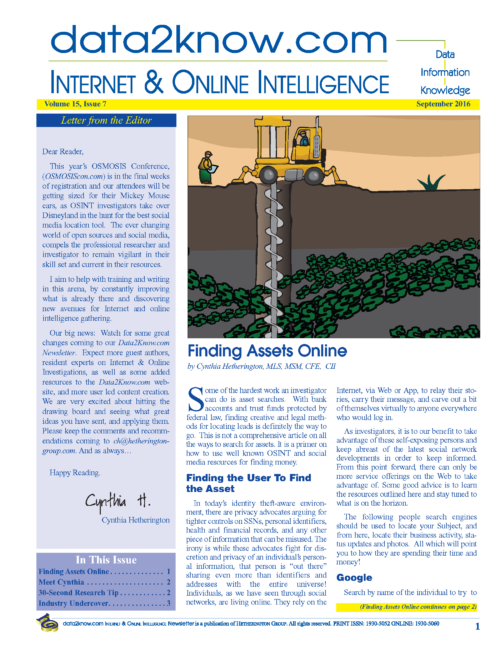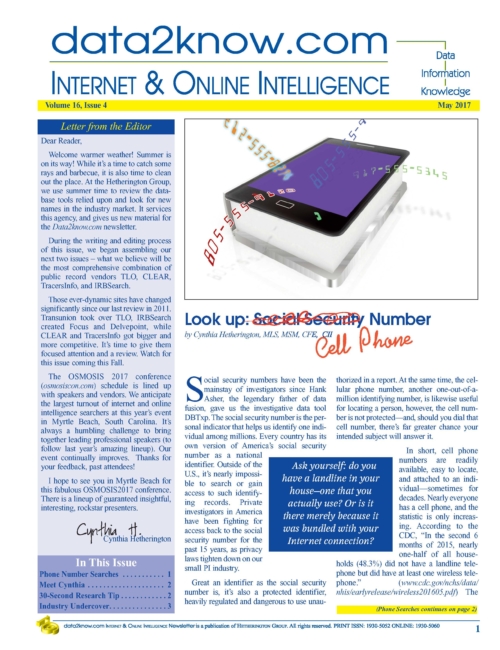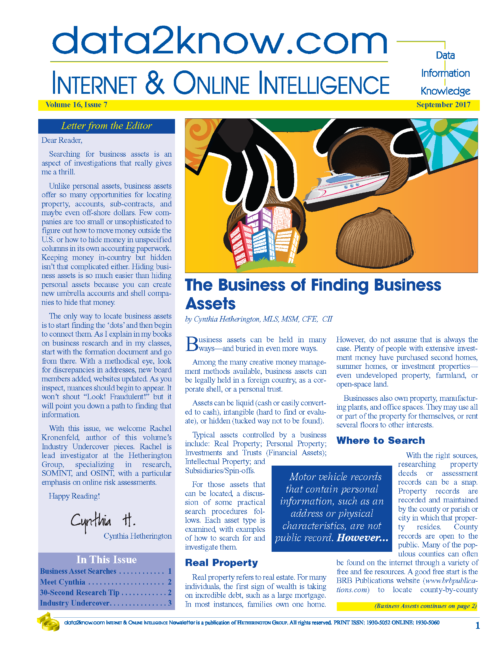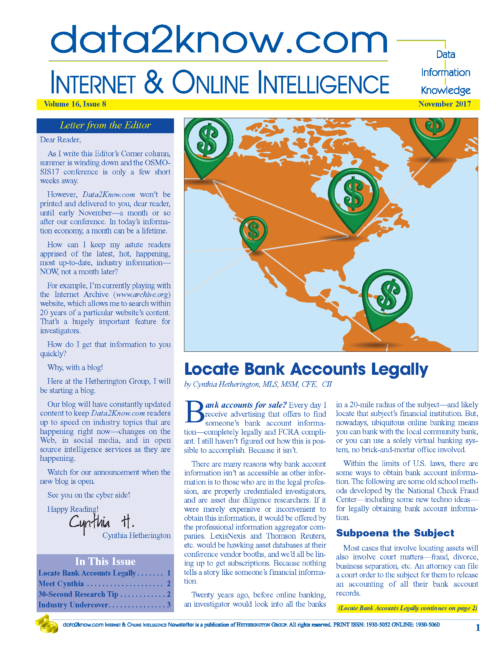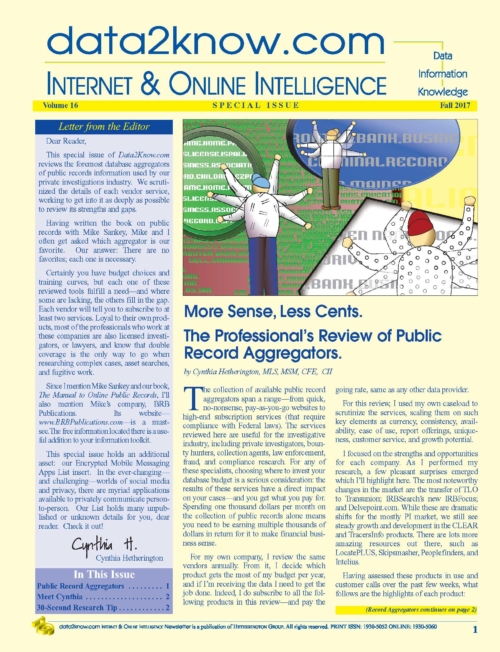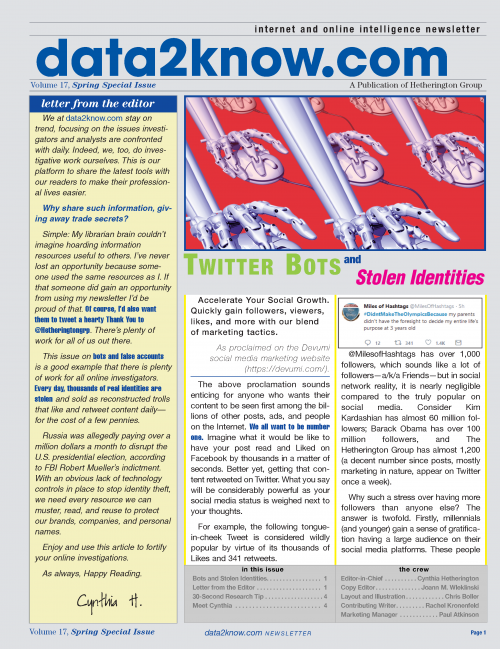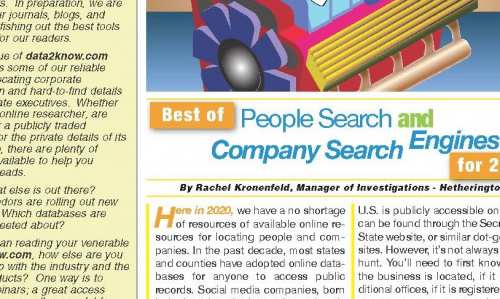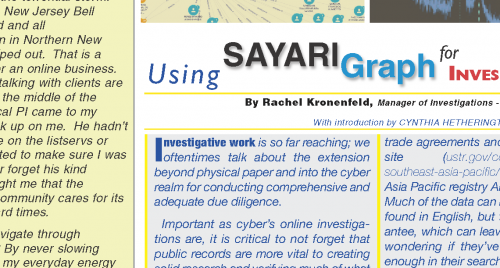-
Data2Know Vol. 15, No. 7
$15.00Finding Assets Online Some of the hardest work an investigator can do is asset searches. With bank accounts and trust funds protected by federal law, finding creative and legal methods for locating leads is definitely the way to go. This is not a comprehensive article on all the ways to search for assets. It is a primer on how to use well known OSINT and social media resources for finding money. -
Data2Know Vol. 15, No. 8
$15.00Protecting Your Image Online
With a good Google search, somebody can find where you live, discover your likes and dislikes, learn what you do with your free time, or what others might think of you. Perhaps even habits you would likely not want known, particularly by coworkers. It is a serious matter for anyone, professional or otherwise, concerned with their own personal security. Have you Googled yourself lately? https://www.hetheringtongroup.com/product/data2know-vol-15-no-8/ -
Data2Know Vol. 16, No. 4
$15.00Look up: Cell Phone Number
Social security numbers have been the mainstay of investigators since Hank Asher, the legendary father of data fusion, gave us the investigative data tool DBTxp. The social security number is the personal indicator that helps us identify one individual among millions. The cellular phone number, another one-out-of-a million identifying number, is likewise useful for locating a person, however, the cell number is not protected—and, should you dial that cell number, there’s far greater chance your intended subject will answer it. -
Data2Know Vol. 16, No. 5
$15.00Public Records Search Pitfalls
This article focuses on some of the pitfalls that the modern investigator needs to be wary of when it comes to public record searching. Learn some of the issues you may come across and how to avoid them. Additional commentary from experts in the public records fields gives further insight into the public records industry. -
Data2Know Vol. 16, No. 7
$15.00The Business of Finding Business Assets Business assets can be held in many ways—and buried in even more ways. Among the many creative money management methods available, business assets can be legally held in a foreign country, as a corporate shell, or a personal trust. Assets can be liquid (cash or easily converted to cash), intangible (hard to find or evaluate), or hidden (tucked way not to be found). Typical assets controlled by a business include: Real Property; Personal Property; Investments and Trusts (Financial Assets); Intellectual Property; and Subsidiaries/Spin-offs. For those assets that can be located, a discussion of some practical search procedures follows. Each asset type is examined, with examples of how to search for and investigate them. what you pay for. -
Data2Know Vol. 16, No. 8
$15.00Locate Bank Accounts Legally
Bank accounts for sale? Every day we receive advertising that offers to find someone’s bank account information—completely legally and FCRA compliant. It's still hard to figured out how this is possible to accomplish. Because it isn't. So what ways are legal, ethical and will get results? -
Professional's Review of Public Record Aggregators
The collection of available public record aggregators span a range—from quick, no-nonsense, pay-as-you-go websites to high-end subscription services (that require compliance with Federal laws). The services reviewed here are useful for the investigative industry, including private investigators, bounty hunters, collection agents, law enforcement, fraud, and compliance research. For any of these specialists, choosing where to invest your database budget is a serious consideration: the results of these services have a direct impact on your cases—and you get what you pay for. -
Twitter Bots & Stolen Identities
Every day, thousands of real identities are stolen and sold as reconstructed trolls that like and retweet content daily—for the cost of a few pennies. This special issue explores how online bots are used to steal identities and examines the impact of social media bots in politics, celebrity lives, and commerce. -
Data2Know Vol. 19 No. 2
$15.00Best of People Search and Company Search Engines
Today’s commodity is data. Everyone is selling a specialized database in their particular arena. Our job as investigators is to find that database; doing so will greatly enhance our skills and give us the edge to set us apart from the rest. -
Data2Know Vol. 19 No. 3
$15.00Using Sayari Graph for Investigations
This article examines the use of Sayari for intelligence analysts and corporate risk management professionals to collect, extract, and analyze data across borders and languages. Sayari can be used for due diligence to reduce risk or to enter a new market, to meet compliance or regulatory requirements, or to prevent fraud, financial crimes, and corruption. -
Data2Know Vol. 19 No. 4
$15.00DNA: The New Open Source
This article examines how the growing trend of DNA testing can help the investigator, but also may be a damaging unwanted intrusion on personal privacy. We discuss how to protect yourself and how to remove any DNA you have left behind. -
Data2Know Vol. 19 No. 5
$15.00TikTok: An OSINT Tool of Today's Youth
This article examines the quickly growing Chinese app and how from an open source intelligence perspective, this novelty app provides researchers and investigators with a plethora of knowledge and useful information.

